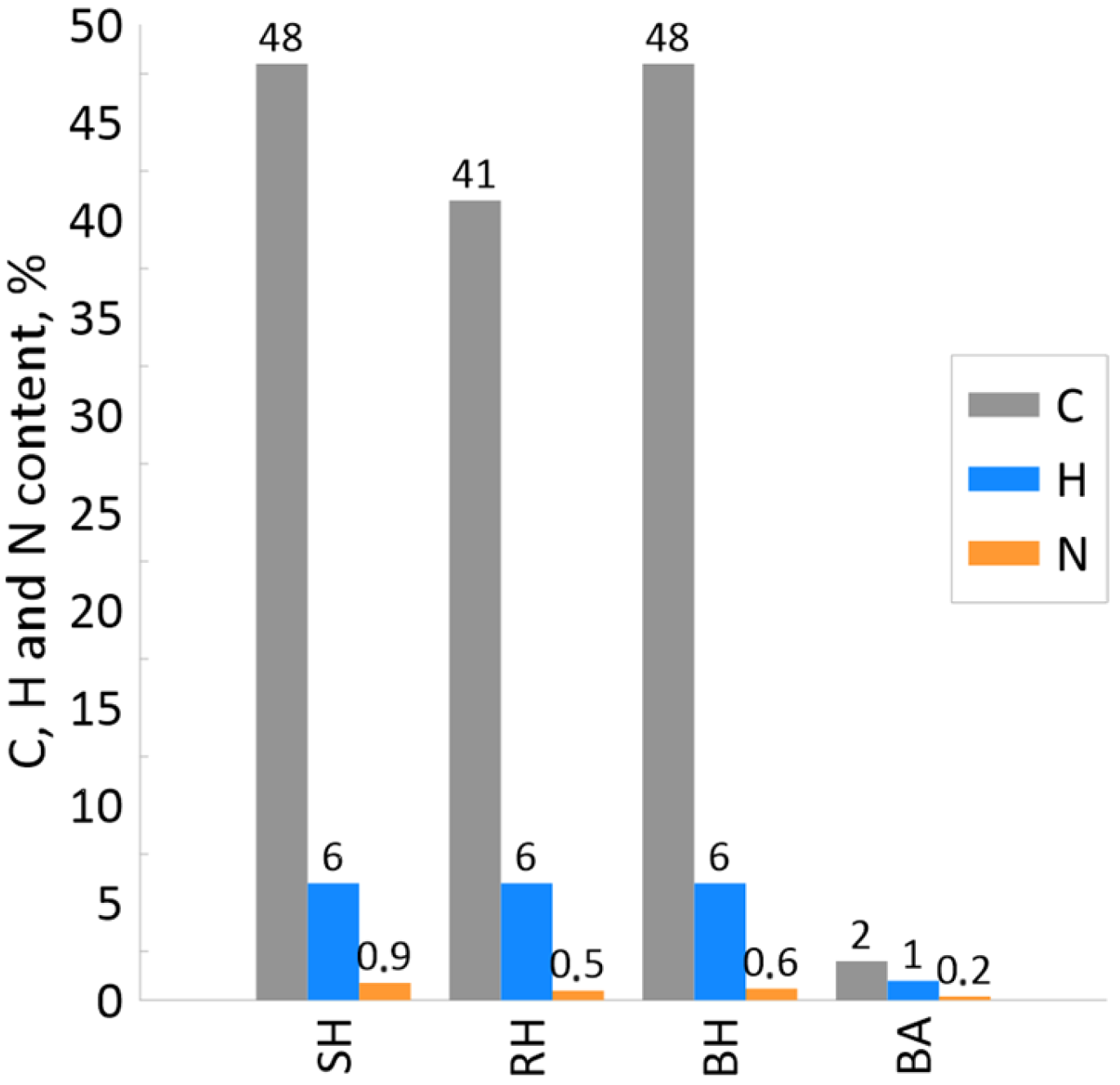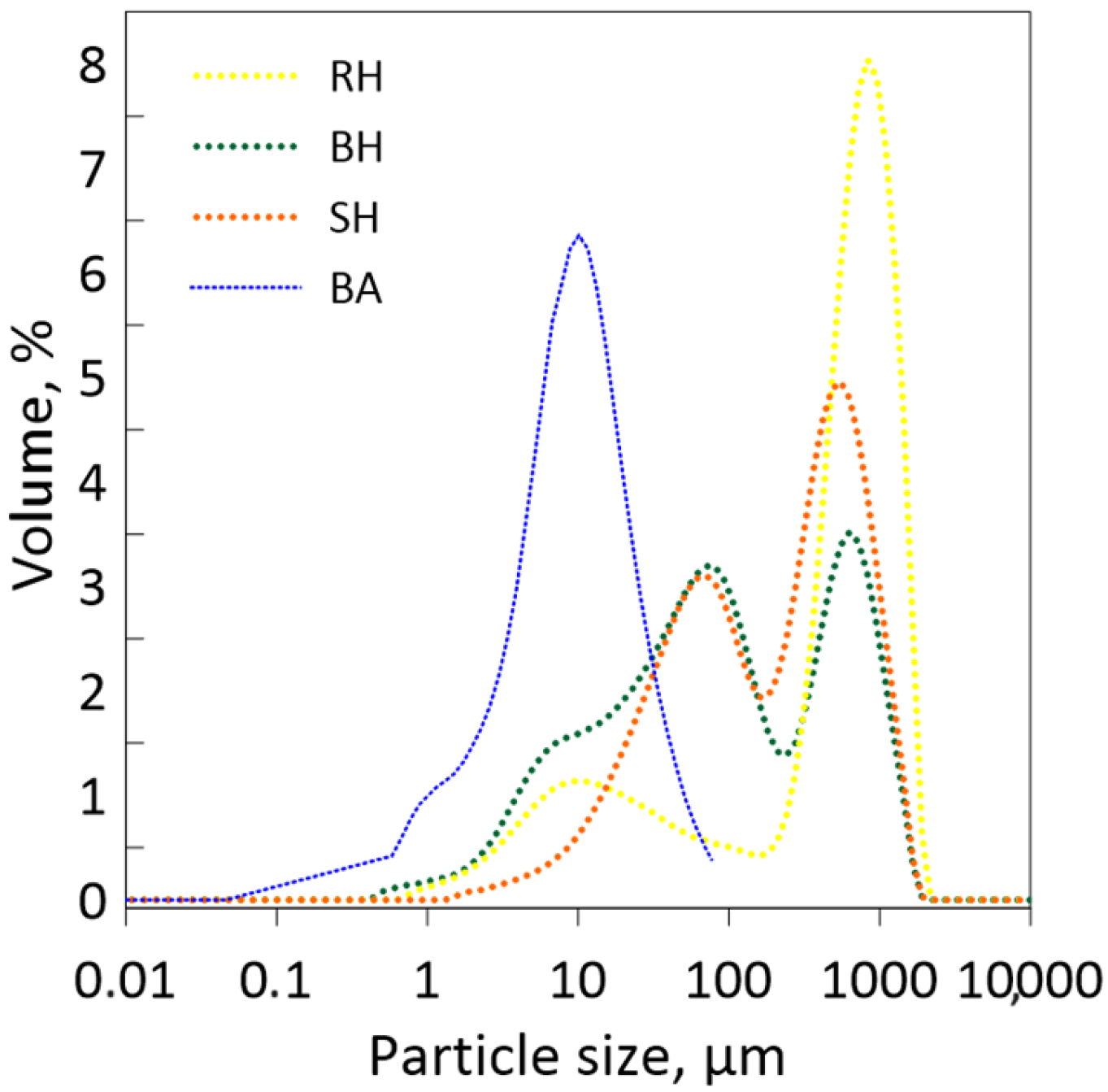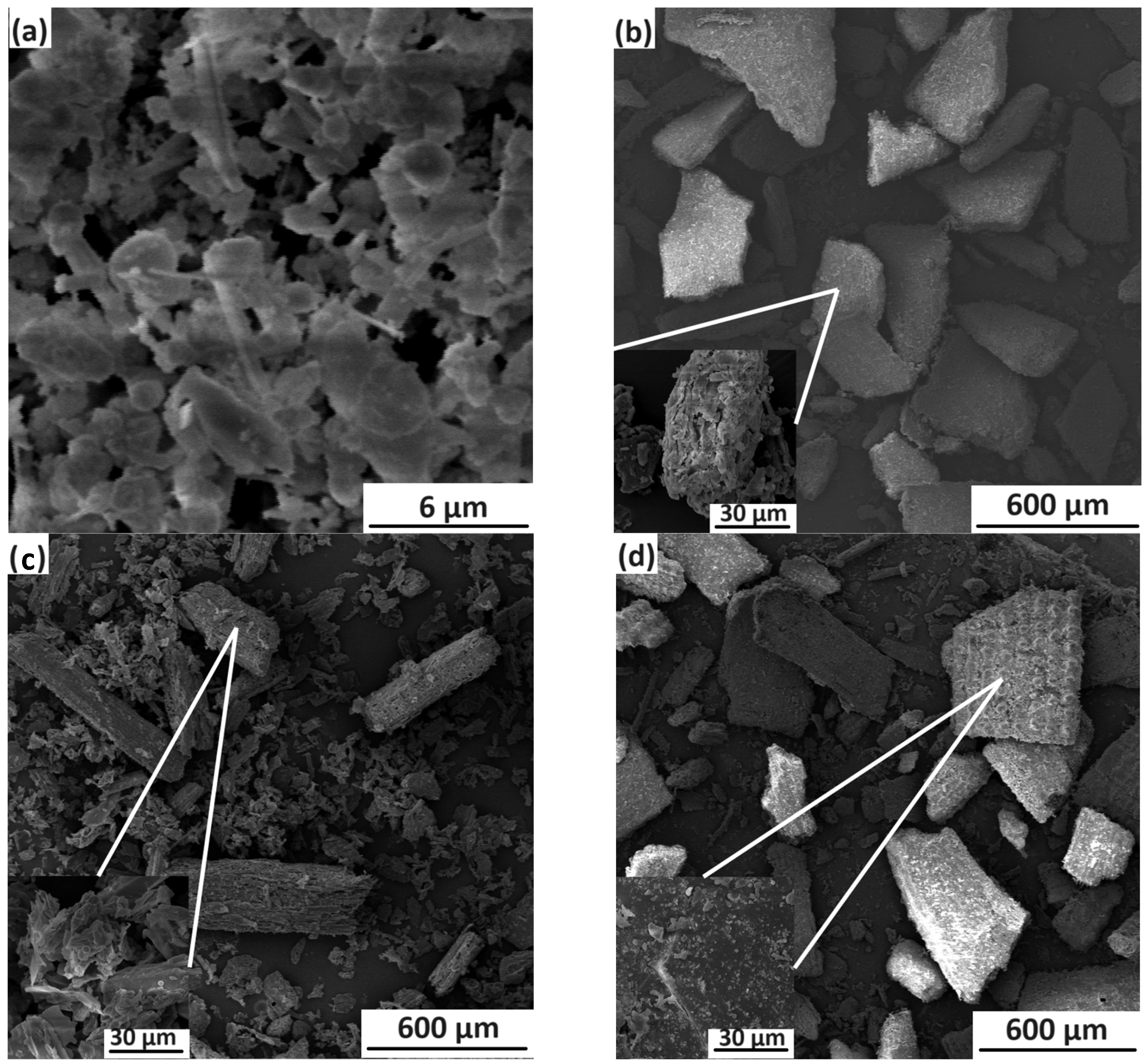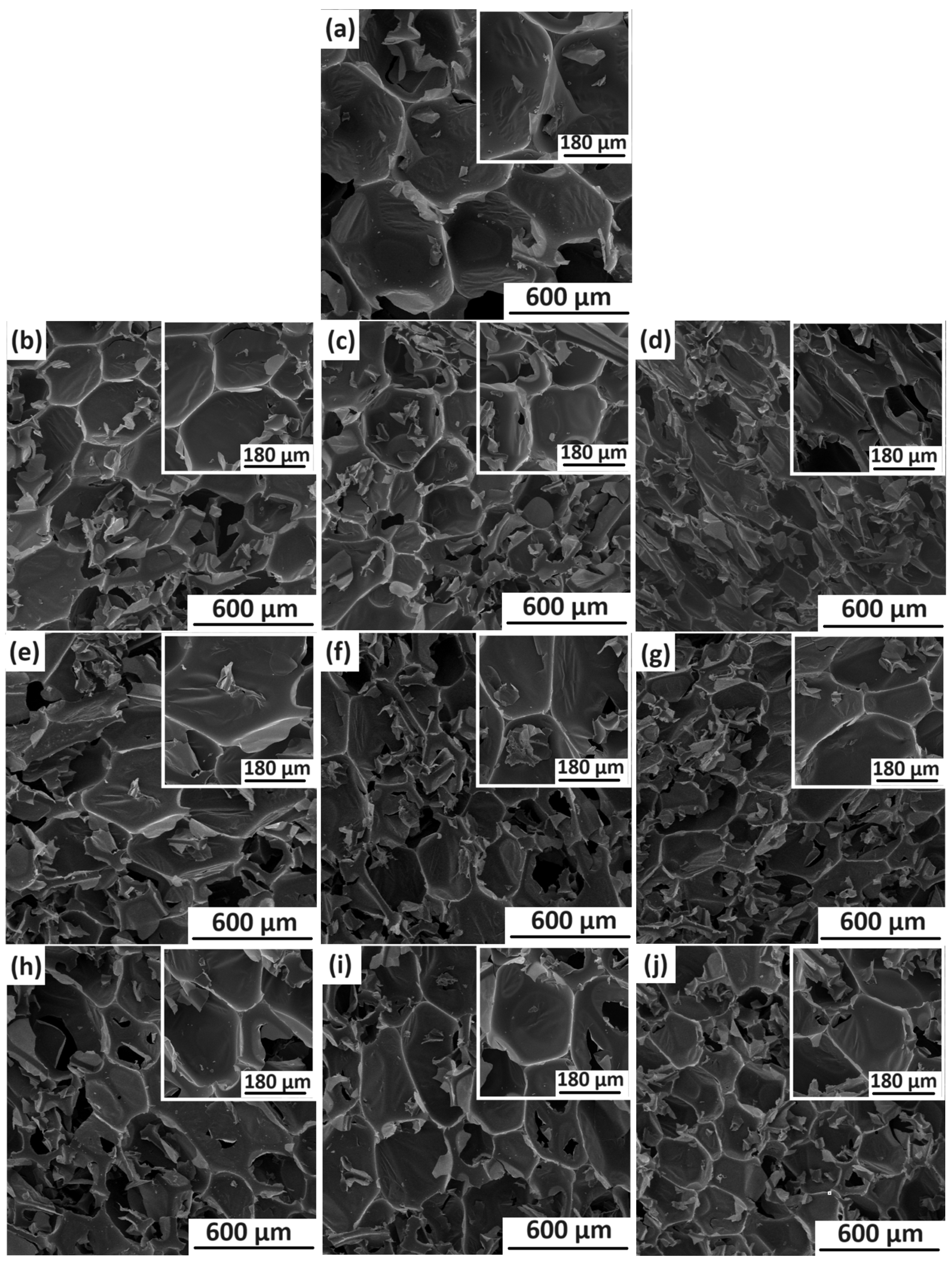Eco-Friendly Polyurethane Foams Enriched with Waste from the Food and Energy Industries
Abstract
:1. Introduction
2. Materials and Methods
2.1. Characteristics of Fillers
2.2. Modified Rigid Polyurethane Foams
2.3. Methods
3. Results and Analysis
3.1. Characterization of Fillers
3.2. Characterization of Rigid Polyurethane Foams
4. Conclusions
Author Contributions
Funding
Data Availability Statement
Conflicts of Interest
References
- Caldeira, C.; Farcal, R.; Moretti, C.; Mancini, L.; Rauscher, H.; Rasmussen, K.; Sintes, J.R.; Sala, S. Safe and Sustainable by Design chemical and Materials; JRC Technical Report; Publications Office of the European Union: Brussels, Belgium, 2022; Volume 123. [Google Scholar]
- Ljungberg, L.Y. Materials selection and design for development of sustainable products. Mater. Des. 2007, 28, 466–479. [Google Scholar] [CrossRef]
- Moshood, T.D.; Nawanir, G.; Mahmud, F.; Mohamad, F.; Ahmad, M.H.; AbdulGhani, A. Sustainability of biodegradable plastics: New problem or solution to solve the global plastic pollution? Curr. Res. Green Sustain. Chem. 2022, 5, 100273. [Google Scholar] [CrossRef]
- Xanthos, M. Functional Fillers for Plastics; Wiley-VCH Verlag GmbH & Co.: Hoboken, NJ, USA, 2010. [Google Scholar] [CrossRef]
- Ramesh, M.; Rajeshkumar, L.N.; Srinivasan, N.; Kumar, D.V.; Balaji, D. Influence of filler material on properties of fiber-reinforced polymer composites: A review. e-Polymers 2022, 22, 898–916. [Google Scholar] [CrossRef]
- Miedzińska, K.; Członka, S.; Kairytė, A.; Strzelec, K.; Strąkowska, A. Rowanberry/vermiculite modified rigid polyurethane foams. J. Cell. Plast. 2024, 60, 117–133. [Google Scholar] [CrossRef]
- Formela, K.; Hejna, A.; Zedler, Ł.; Przybysz, M.; Ryl, J.; Saeb, M.R.; Piszczyk, Ł. Structural, thermal and physico-mechanical properties of polyurethane/brewers’ spent grain composite foams modified with ground tire rubber. Ind. Crops Prod. 2017, 108, 844–852. [Google Scholar] [CrossRef]
- Agrawal, A.; Kaur, R.; Walia, R.S. Investigation on flammability of rigid polyurethane foam-mineral fillers composite. Fire Mater. 2019, 43, 917–927. [Google Scholar] [CrossRef]
- Dzulkifli, M.H.; Zainal, S.Z.; Majid, R.A.; Yahya, M.Y. Industrial Rockwool Fiber Wastes as Reinforcement in Rigid Polyurethane Foam: Preparation and Characterization. Fibers Polym. 2023, 24, 329–336. [Google Scholar] [CrossRef]
- Leszczyńska, M.; Ryszkowska, J.; Szczepkowski, L.; Kurańska, M.; Prociak, A.; Leszczyński, M.K.; Gloc, M.; Antos-Bielska, M.; Mizera, K. Cooperative effect of rapeseed oil-based polyol and egg shells on the structure and properties of rigid polyurethane foams. Polym. Test. 2020, 90, 106696. [Google Scholar] [CrossRef]
- Paciorek-Sadowska, J.; Czupryński, B.; Borowicz, M.; Liszkowska, J. Rigid polyurethane–polyisocyanurate foams modified with grain fraction of fly ashes. J. Cell. Plast. 2020, 56, 53–72. [Google Scholar] [CrossRef]
- Khaleel, M.; Soykan, U.; Çetin, S. Influences of turkey feather fiber loading on significant characteristics of rigid polyurethane foam: Thermal degradation, heat insulation, acoustic performance, air permeability and cellular structure. Constr. Build. Mater. 2021, 308, 125014. [Google Scholar] [CrossRef]
- da Silva, V.R.; Mosiewicki, M.A.; Yoshida, M.I.; da Silva, M.C.; Stefani, P.M.; Marcovich, N.E. Polyurethane foams based on modified tung oil and reinforced with rice husk ash I: Synthesis and physical chemical characterization. Polym. Test. 2013, 32, 438–445. [Google Scholar] [CrossRef]
- Członka, S.; Bertino, M.F.; Strzelec, K. Rigid polyurethane foams reinforced with industrial potato protein. Polym. Test. 2018, 68, 135–145. [Google Scholar] [CrossRef]
- Leszczynska, M.; Ryszkowska, J.; Szczepkowski, L. Rigid polyurethane foam composites with nut shells. Polimery 2020, 65, 728–737. [Google Scholar] [CrossRef]
- Akkoyun, M.; Akkoyun, S. Blast furnace slag or fly ash filled rigid polyurethane composite foams: A comprehensive investigation. J. Appl. Polym. Sci. 2019, 136, 47433. [Google Scholar] [CrossRef]
- Tiuc, A.-E.; Vermeşan, H.; Gabor, T.; Vasile, O. Improved Sound Absorption Properties of Polyurethane Foam Mixed with Textile Waste. Energy Procedia 2016, 85, 559–565. [Google Scholar] [CrossRef]
- European Commission. 2050 Long-Term Strategy. Available online: https://climate.ec.europa.eu/eu-action/climate-strategies-targets/2050-long-term-strategy_en (accessed on 16 April 2024).
- Chang, L.-C.; Sain, M.; Kortschot, M. Effect of mixing conditions on the morphology and performance of fiber-reinforced polyurethane foam. J. Cell. Plast. 2014, 51, 103–119. [Google Scholar] [CrossRef]
- Alis, A.; Majid, R.A.; Nasir, I.A.A.; Mustaffa, N.S.; Hassan, W.H.W. Rigid polyurethane/oil palm fibre biocomposite foam. AIP Conf. Proc. 2017, 1865, 040005. [Google Scholar]
- Islam, T.; Das, S.C.; Saha, J.; Paul, D.; Islam, M.T.; Rahman, M.; Khan, M.A. Effect of Coconut Shell Powder as Filler on the Mechanical Properties of Coir-polyester Composites. Chem. Mater. Eng. 2017, 5, 75–82. [Google Scholar] [CrossRef]
- Członka, S.; Strąkowska, A.; Kairytė, A. Effect of walnut shells and silanized walnut shells on the mechanical and thermal properties of rigid polyurethane foams. Polym. Test. 2020, 87, 106534. [Google Scholar] [CrossRef]
- Sair, S.; Oushabi, A.; Kammouni, A.; Tanane, O.; Abboud, Y.; El Bouari, A. Mechanical and thermal conductivity properties of hemp fiber reinforced polyurethane composites. Case Stud. Constr. Mater. 2018, 8, 203–212. [Google Scholar] [CrossRef]
- Dukarska, D.; Walkiewicz, J.; Derkowski, A.; Mirski, R. Properties of Rigid Polyurethane Foam Filled with Sawdust from Primary Wood Processing. Materials 2022, 15, 5361. [Google Scholar] [CrossRef] [PubMed]
- Chen, S.; Jiang, Y. The acoustic property study of polyurethane foam with addition of bamboo leaves particles. Polym. Compos. 2018, 39, 1370–1381. [Google Scholar] [CrossRef]
- Ekici, B.; Kentli, A.; Küçük, H. Improving Sound Absorption Property of Polyurethane Foams by Adding Tea-Leaf Fibers. Arch. Acoust. 2012, 37, 515–520. [Google Scholar] [CrossRef]
- Kairytė, A.; Kizinievič, O.; Kizinievič, V.; Kremensas, A. Synthesis of biomass-derived bottom waste ash based rigid biopolyurethane composite foams: Rheological behaviour, structure and performance characteristics. Compos. Part A Appl. Sci. Manuf. 2019, 117, 193–201. [Google Scholar] [CrossRef]
- Kuźnia, M.; Zygmunt-Kowalska, B.; Szajding, A.; Magiera, A.; Stanik, R.; Gude, M. Comparative Study on Selected Properties of Modified Polyurethane Foam with Fly Ash. Int. J. Mol. Sci. 2022, 23, 9725. [Google Scholar] [CrossRef] [PubMed]
- Yurtseven, R.; Tarakcilar, A.R.; Topçu, M. The effects of different fly ash fillers on the mechanical properties, thermal and fire behaviors of rigid polyurethane foams. J. Fac. Eng. Archit. Gazi Univ. 2013, 28. Available online: https://hdl.handle.net/11499/7875 (accessed on 20 April 2024).
- Usta, N. Investigation of fire behavior of rigid polyurethane foams containing fly ash and intumescent flame retardant by using a cone calorimeter. J. Appl. Polym. Sci. 2011, 124, 3372–3382. [Google Scholar] [CrossRef]
- Magiera, A.; Kuźnia, M.; Błoniarz, A.; Magdziarz, A. Rigid Polyurethane Foams Modified with Soybean-Husk-Derived Ash as Potential Insulating Materials. Processes 2023, 11, 3416. [Google Scholar] [CrossRef]
- da Silva, V.R.; Mosiewicki, M.A.; Yoshida, M.I.; da Silva, M.C.; Stefani, P.M.; Marcovich, N.E. Polyurethane foams based on modified tung oil and reinforced with rice husk ash II: Mechanical characterization. Polym. Test. 2013, 32, 665–672. [Google Scholar] [CrossRef]
- EN ISO 845:2009; Cellular Plastics and Rubbers—Determination of Apparent Density. ISO: Geneva, Switzerland, 2009.
- PN-92/C-89083; Determination of Formaldehyde Content in Urea and Urea-Formaldehyde Resins. PKN: Warsaw, Poland, 1992.
- ASTM D570-98; Standard Test Method for Water Absorption of Plastics. ASTM International: West Conshohocken, PA, USA, 1998.
- ASTM C421-08; Standard Test Method for Tumbling Friability of Preformed Insulating Blocks. ASTM International: West Conshohocken, PA, USA, 2008.
- EN ISO 14125:1998; Fibre-Reinforced Plastic Composites—Determination of Flexural Properties. ISO: Geneva, Switzerland, 1998.
- EN ISO 4589-2:2006; EN ISO 4589-2:2006; Plastics—Determination of Burning Behaviour by Oxygen Index—Part 2: Ambient-Temperature Test. ISO: Geneva, Switzerland, 2006.
- EN ISO 13927:2001; Plastics—Simple Heat Release Test Using a Conical Radiant Heater and a Thermopile Detector. ISO: Geneva, Switzerland, 2001.
- EN 60695-11-10:1999; Fire Hazard Testing—Part 11-10: Test Flames—50 W Horizontal and Vertical Flame Test Methods. IEC: Geneva, Switzerland, 1999.
- EN ISO 9772:2012; Cellular Plastics—Determination of Horizontal Burning Characteristics of Small Specimens Subjected to a Small Flame. ISO: Geneva, Switzerland, 2012.
- ISO 1716:2018; Determination of the Calorific Value. International Organization for Standardization: Geneva, Switzerland, 2018.
- Lu, Z.; Chen, X.; Yao, S.; Qin, H.; Zhang, L.; Yao, X.; Yu, Z.; Lu, J. Feasibility study of gross calorific value, carbon content, volatile matter content and ash content of solid biomass fuel using laser-induced breakdown spectroscopy. Fuel 2019, 258, 116150. [Google Scholar] [CrossRef]
- Zygmunt-Kowalska, B.; Pielichowska, K.; Trestka, P.; Ziąbka, M.; Kuźnia, M. The Effect of Ash Silanization on the Selected Properties of Rigid Polyurethane Foam/Coal Fly Ash Composites. Energies 2022, 15, 2014. [Google Scholar] [CrossRef]
- Barczewski, M.; Sałasińska, K.; Szulc, J. Application of sunflower husk, hazelnut shell and walnut shell as waste agricultural fillers for epoxy-based composites: A study into mechanical behavior related to structural and rheological properties. Polym. Test. 2019, 75, 1–11. [Google Scholar] [CrossRef]
- Kitano, T.; Kataoka, T.; Nishimura, T.; Sakai, T. Relative viscosities of polymer melts filled with inorganic fillers. Rheol. Acta 1980, 19, 764–769. [Google Scholar] [CrossRef]
- Marvi-Mashhadi, M.; Lopes, C.; Llorca, J. Effect of anisotropy on the mechanical properties of polyurethane foams: An experimental and numerical study. Mech. Mater. 2018, 124, 143–154. [Google Scholar] [CrossRef]
- Olszewski, A.; Kosmela, P.; Vēvere, L.; Kirpluks, M.; Cabulis, U.; Piszczyk, Ł. Effect of bio-polyol molecular weight on the structure and properties of polyurethane-polyisocyanurate (PUR-PIR) foams. Sci. Rep. 2024, 14, 812. [Google Scholar] [CrossRef]
- Donati, N.; Spada, J.C.; Tessaro, I.C. Recycling rice husk ash as a filler on biodegradable cassava starch-based foams. Polym. Bull. 2022, 80, 10231–10248. [Google Scholar] [CrossRef]
- Głowacz-Czerwonka, D.; Zakrzewska, P.; Oleksy, M.; Pielichowska, K.; Kuźnia, M.; Telejko, T. The influence of biowaste-based fillers on the mechanical and fire properties of rigid polyurethane foams. Sustain. Mater. Technol. 2023, 36, e00610. [Google Scholar] [CrossRef]
- Gerometta, M.; Gabrion, X.; Lagorce, A.; Thibaud, S.; Karbowiak, T. Towards better understanding of the strain–stress curve of cork: A structure–mechanical properties approach. Mater. Des. 2023, 235, 112376. [Google Scholar] [CrossRef]
- Mouritz, A.P. Durability of composites exposed to elevated temperature and fire. In Durability of Composites for Civil Structural Applications; Woodhead Publishing: Sawston, UK, 2007; pp. 98–125. [Google Scholar] [CrossRef]
- Cao, Z.-J.; Dong, X.; Fu, T.; Deng, S.-B.; Liao, W.; Wang, Y.-Z. Coated vs. naked red phosphorus: A comparative study on their fire retardancy and smoke suppression for rigid polyurethane foams. Polym. Degrad. Stab. 2017, 136, 103–111. [Google Scholar] [CrossRef]
- Członka, S.; Strąkowska, A.; Strzelec, K.; Kairytė, A.; Kremensas, A. Melamine, silica, and ionic liquid as a novel flame retardant for rigid polyurethane foams with enhanced flame retardancy and mechanical properties. Polym. Test. 2020, 87, 106511. [Google Scholar] [CrossRef]





| Sample | Component A [g] | Component B [g] | BA [g] | SH [g] | RH [g] | BH [g] | Description |
|---|---|---|---|---|---|---|---|
| PU | 60 | 72 | — | — | — | — | unmodified foam |
| PU_5S | 60 | 72 | 3.48 | 3.48 | — | — | foam containing 2.5% BA and 2.5% SH |
| PU_10S | 60 | 72 | 7.32 | 7.32 | — | — | foam containing 5% BA and 5% SH |
| PU_15S | 60 | 72 | 11.52 | 11.52 | — | — | foam containing 7.5% BA and 7.5% SH |
| PU_5R | 60 | 72 | 3.48 | — | 3.48 | — | foam containing 2.5% BA and 2.5% RH |
| PU_10R | 60 | 72 | 7.32 | — | 7.32 | — | foam containing 5% BA and 5% RH |
| PU_15R | 60 | 72 | 11.52 | — | 11.5 | — | foam containing 7.5% BA and 7.5% RH |
| PU_5B | 60 | 72 | 3.48 | — | — | 3.48 | foam containing 2.5% BA and 2.5% BH |
| PU_10B | 60 | 72 | 7.32 | — | — | 7.32 | foam containing 5% BA and 5% BH |
| PU_15B | 60 | 72 | 11.52 | — | — | 11.52 | foam containing 7.5% BA and 7.5% BH |
| Apparent Density [kg⋅m−3] | Dimensional Stability | Loss in Mass | Water Absorption [%] | |||
|---|---|---|---|---|---|---|
| (Δl, 20 h,150 °C) [%] | (Δl, 40 h,150 °C) [%] | (Δl, 20 h,150 °C) [%] | (Δl, 40 h,150 °C) [%] | |||
| PU | 36.09 | 3.86 | 4.18 | 9.23 | 9.23 | 36.14 |
| PU_5S | 40.82 | 0.27 | 0.52 | 7.87 | 8.99 | 25.49 |
| PU_10S | 41.64 | 1.01 | 1.03 | 8.05 | 9.20 | 26.66 |
| PU_15S | 51.75 | 2.78 | 2.20 | 9.02 | 9.77 | 37.71 |
| PU_5R | 38.70 | 0.12 | 0.18 | 7.55 | 8.49 | 28.23 |
| PU_10R | 39.85 | 0.52 | 0.84 | 8.33 | 9.38 | 29.56 |
| PU_15R | 42.66 | 1.06 | 1.34 | 9.09 | 10.00 | 31.41 |
| PU_5B | 38.34 | 0.90 | 1.64 | 8.40 | 9.24 | 26.65 |
| PU_10B | 41.28 | 1.58 | 1.94 | 8.82 | 9.80 | 28.86 |
| PU_15B | 43.94 | 1.60 | 1.98 | 9.92 | 10.74 | 35.51 |
| Brittleness [%] |  | |
| PU | 16.98 | |
| PU_5S | 24.81 | |
| PU_10S | 19.07 | |
| PU_15S | 16.44 | |
| PU_5R | 24.81 | |
| PU_10R | 24.36 | |
| PU_15R | 17.47 | |
| PU_5B | 16.51 | |
| PU_10B | 18.70 | |
| PU_15B | 30.58 |
| Gross Calorific Value, MJ·kg−1 | LOI, % | UL 94HB, mm·min−1 | UL 94V | |
|---|---|---|---|---|
| PU | 26.26 | 20.4 | 12.32 | N.R. |
| PU_5S | 25.15 | 21.3 | 9.23 | N.R. |
| PU_10S | 24.49 | 21.3 | 8.23 | N.R. |
| PU_15S | 23.56 | 21.4 | 8.43 | N.R. |
| PU_5R | 25.71 | 21.2 | 11.04 | N.R. |
| PU_10R | 24.25 | 21.6 | 11.28 | N.R. |
| PU_15R | 23.57 | 21.2 | 11.15 | N.R. |
| PU_5B | 25.47 | 21.3 | 10.53 | N.R. |
| PU_10B | 24.25 | 21.4 | 7.86 | N.R. |
| PU_15B | 23.57 | 21.5 | 8.03 | N.R. |
| TTI, s | HRR, kW·m−2 | p-HRR, kW·m−2 | PML, % | |
|---|---|---|---|---|
| PU | 4 | 63.88 | 77.70 | 85.70 |
| PU_5S | 8 | 69.80 | 84.25 | 84.20 |
| PU_10S | 6 | 67.60 | 82.56 | 78.40 |
| PU_15S | 6 | 61.11 | 79.03 | 73.10 |
| PU_5R | 8 | 65.07 | 84.60 | 81.21 |
| PU_10R | 6 | 62.05 | 80.53 | 79.20 |
| PU_15R | 6 | 59.74 | 82.10 | 72.60 |
| PU_5B | 9 | 51.80 | 67.03 | 78.60 |
| PU_10B | 7 | 59.35 | 74.45 | 76.10 |
| PU_15B | 6 | 67.65 | 84.79 | 76.40 |
Disclaimer/Publisher’s Note: The statements, opinions and data contained in all publications are solely those of the individual author(s) and contributor(s) and not of MDPI and/or the editor(s). MDPI and/or the editor(s) disclaim responsibility for any injury to people or property resulting from any ideas, methods, instructions or products referred to in the content. |
© 2024 by the authors. Licensee MDPI, Basel, Switzerland. This article is an open access article distributed under the terms and conditions of the Creative Commons Attribution (CC BY) license (https://creativecommons.org/licenses/by/4.0/).
Share and Cite
Zakrzewska, P.; Zygmunt-Kowalska, B.; Kuźnia, M.; Głowacz-Czerwonka, D.; Oleksy, M.; Sieradzka, M. Eco-Friendly Polyurethane Foams Enriched with Waste from the Food and Energy Industries. Energies 2024, 17, 3829. https://doi.org/10.3390/en17153829
Zakrzewska P, Zygmunt-Kowalska B, Kuźnia M, Głowacz-Czerwonka D, Oleksy M, Sieradzka M. Eco-Friendly Polyurethane Foams Enriched with Waste from the Food and Energy Industries. Energies. 2024; 17(15):3829. https://doi.org/10.3390/en17153829
Chicago/Turabian StyleZakrzewska, Patrycja, Beata Zygmunt-Kowalska, Monika Kuźnia, Dorota Głowacz-Czerwonka, Mariusz Oleksy, and Małgorzata Sieradzka. 2024. "Eco-Friendly Polyurethane Foams Enriched with Waste from the Food and Energy Industries" Energies 17, no. 15: 3829. https://doi.org/10.3390/en17153829
APA StyleZakrzewska, P., Zygmunt-Kowalska, B., Kuźnia, M., Głowacz-Czerwonka, D., Oleksy, M., & Sieradzka, M. (2024). Eco-Friendly Polyurethane Foams Enriched with Waste from the Food and Energy Industries. Energies, 17(15), 3829. https://doi.org/10.3390/en17153829










